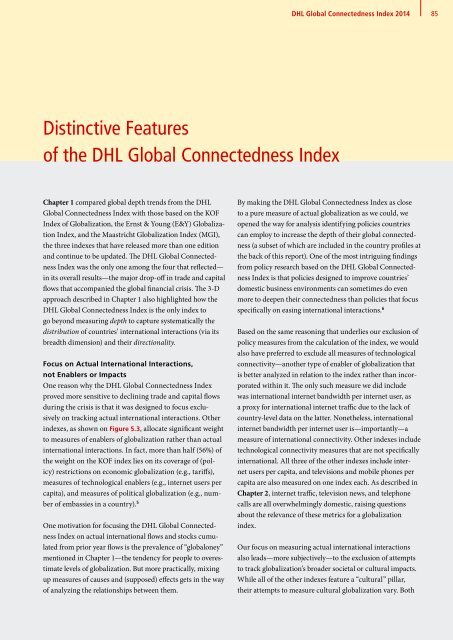DHL Global Connectedness Index 2014
DHL Global Connectedness Index 2014
DHL Global Connectedness Index 2014
- No tags were found...
You also want an ePaper? Increase the reach of your titles
YUMPU automatically turns print PDFs into web optimized ePapers that Google loves.
<strong>DHL</strong> <strong>Global</strong> <strong>Connectedness</strong> <strong>Index</strong> <strong>2014</strong><br />
85<br />
Distinctive Features<br />
of the <strong>DHL</strong> <strong>Global</strong> <strong>Connectedness</strong> <strong>Index</strong><br />
Chapter 1 compared global depth trends from the <strong>DHL</strong><br />
<strong>Global</strong> <strong>Connectedness</strong> <strong>Index</strong> with those based on the KOF<br />
<strong>Index</strong> of <strong>Global</strong>ization, the Ernst & Young (E&Y) <strong>Global</strong>ization<br />
<strong>Index</strong>, and the Maastricht <strong>Global</strong>ization <strong>Index</strong> (MGI),<br />
the three indexes that have released more than one edition<br />
and continue to be updated. The <strong>DHL</strong> <strong>Global</strong> <strong>Connectedness</strong><br />
<strong>Index</strong> was the only one among the four that reflected—<br />
in its overall results—the major drop-off in trade and capital<br />
flows that accompanied the global financial crisis. The 3-D<br />
approach described in Chapter 1 also highlighted how the<br />
<strong>DHL</strong> <strong>Global</strong> <strong>Connectedness</strong> <strong>Index</strong> is the only index to<br />
go beyond measuring depth to capture systematically the<br />
distribution of countries’ international interactions (via its<br />
breadth dimension) and their directionality.<br />
Focus on Actual International Interactions,<br />
not Enablers or Impacts<br />
One reason why the <strong>DHL</strong> <strong>Global</strong> <strong>Connectedness</strong> <strong>Index</strong><br />
proved more sensitive to declining trade and capital flows<br />
during the crisis is that it was designed to focus exclusively<br />
on tracking actual international interactions. Other<br />
indexes, as shown on Figure 5.3, allocate significant weight<br />
to measures of enablers of globalization rather than actual<br />
international interactions. In fact, more than half (56%) of<br />
the weight on the KOF index lies on its coverage of (policy)<br />
restrictions on economic globalization (e.g., tariffs),<br />
measures of technological enablers (e.g., internet users per<br />
capita), and measures of political globalization (e.g., number<br />
of embassies in a country). 5<br />
One motivation for focusing the <strong>DHL</strong> <strong>Global</strong> <strong>Connectedness</strong><br />
<strong>Index</strong> on actual international flows and stocks cumulated<br />
from prior year flows is the prevalence of “globaloney”<br />
mentioned in Chapter 1—the tendency for people to overestimate<br />
levels of globalization. But more practically, mixing<br />
up measures of causes and (supposed) effects gets in the way<br />
of analyzing the relationships between them.<br />
By making the <strong>DHL</strong> <strong>Global</strong> <strong>Connectedness</strong> <strong>Index</strong> as close<br />
to a pure measure of actual globalization as we could, we<br />
opened the way for analysis identifying policies countries<br />
can employ to increase the depth of their global connectedness<br />
(a subset of which are included in the country profiles at<br />
the back of this report). One of the most intriguing findings<br />
from policy research based on the <strong>DHL</strong> <strong>Global</strong> <strong>Connectedness</strong><br />
<strong>Index</strong> is that policies designed to improve countries’<br />
domestic business environments can sometimes do even<br />
more to deepen their connectedness than policies that focus<br />
specifically on easing international interactions. 6<br />
Based on the same reasoning that underlies our exclusion of<br />
policy measures from the calculation of the index, we would<br />
also have preferred to exclude all measures of technological<br />
connectivity—another type of enabler of globalization that<br />
is better analyzed in relation to the index rather than incorporated<br />
within it. The only such measure we did include<br />
was international internet bandwidth per internet user, as<br />
a proxy for international internet traffic due to the lack of<br />
country-level data on the latter. Nonetheless, international<br />
internet bandwidth per internet user is—importantly—a<br />
measure of international connectivity. Other indexes include<br />
technological connectivity measures that are not specifically<br />
international. All three of the other indexes include internet<br />
users per capita, and televisions and mobile phones per<br />
capita are also measured on one index each. As described in<br />
Chapter 2, internet traffic, television news, and telephone<br />
calls are all overwhelmingly domestic, raising questions<br />
about the relevance of these metrics for a globalization<br />
index.<br />
Our focus on measuring actual international interactions<br />
also leads—more subjectively—to the exclusion of attempts<br />
to track globalization’s broader societal or cultural impacts.<br />
While all of the other indexes feature a “cultural” pillar,<br />
their attempts to measure cultural globalization vary. Both





